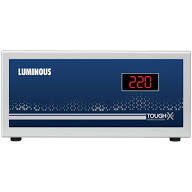UNINTERRUPTED POWER SUPPLY
(UPS)
An uninterruptible power supply
or uninterruptible power source (UPS) is an electrical apparatus that provides emergency power to a load when the input power source or mains power fails. A UPS differs from an auxiliary or emergency power system or standby generator in that it will provide near-instantaneous protection from input power interruptions, by supplying energy stored in batteries.
Difference between online UPS and offline UPS
The major point that differentiates between the online UPS and offline UPS is that the online UPS supplies power from the AC mains to the Load through the rectifier and inverter combination while the Offline UPS directly supplies power from AC mains to the load.
UPS battery connected in series
Batteries achieve the desired operating voltage by connecting several cells in series; each cell adds its voltage potential to derive at the total terminal voltage. Parallel connection attains higher capacity by adding up the total ampere-hour (Ah)
kind of batteries are used in UPS
There are three main types of batteries used in uninterruptible power supplies: Nickel-Cadmium, Lead-Acid, and Lithium-Ion. There isn't a single “best” UPS battery technology – the choice should be made on a case-by-case basis.
Voltage of UPS battery
13.5 volts
Normal UPS battery voltages are 2.25 volts per cell or 13.5 volts DC for a “12” volt battery. Battery voltages under charge should be 13.5 volts on average for all batteries. After isolation, the open cell (non-charging state) should be slightly lower than 13.5.
Improve my UPS battery life
5 Tips and Tricks to Extend UPS Battery Life
Install your UPS unit in a cool and dry place. Your UPS must be kept in a location with a temperature not exceeding 77° F (25° C). ...
Store replacement batteries properly.
Auto Transfer Switch
A transfer switch is an electrical switch that switches a load between two sources. ... An Automatic Transfer Switch (ATS) is often installed where a backup generator is located, so that the generator may provide temporary electrical power if the utility source fails.
Difference between ATS and STS
A Static Transfer Switch (STS) utilizes a static electronic component (SCR), which permits a transfer in less than four milliseconds (1/4 of an electrical cycle). ... On the other hand, an Automatic Transfer Switch (ATS) relies on moving parts, and makes a significantly slower transfer than Static Transfer Switches.
SMF (Sealed Maintenance Free) batteries also known as the Value Regulated Lead Acid (VRLA) batteries are the flat plate batteries that do not require topping-up and normally do not emit any fumes or gases on a continuous basis.
voltage stabilizer
A voltage stabilizer is an electrical appliance used to feed constant voltage current to electrical gadgets like ACs and computers, and protects them from damage due to voltage fluctuations.
Difference between voltage regulator and stabilizer
If there is any difference between the two voltages, the voltage regulator will automatically compensate to provide the right output. ... A voltage stabilizer is basically a voltage regulator that is used in homes to output a constant voltage even if the backend power supply fluctuates for any reason.
voltage stabilizer required for LED TV
Modern LCD,LED and other types of TV's have capability to work on voltages as low as 150V -190V. No,you don't need a voltage stabilizer. ... Previously,when we used CRT monitors the Tv sets used to have Transformers which would increase the 230V to a higher voltage ranges (in KV's) thus enabling the CRT to work.
Inverter
A power inverter, or inverter, is a power electronic device or circuitry that changes direct current (DC) to alternating current (AC). The input voltage, output voltage and frequency, and overall power handling depend on the design of the specific device or circuitry.
size inverter do I need to power my house
You would need an inverter with a continuous rating of approximately 1500 watts and with a peak/surge rating of approximately 3500 watts. It is always advisable to build in a safety factor by overrating the continuous rating by 20 – 25% .
Long will a 12v battery last with an inverter
If you max out the inverter at 2000 watts, you are pulling 2000 watts /12 volts = 166.6 DC amps per hour. If you use a 200 amp 12 volt battery you would divide 200 amp battery / 166.6 amps = 1.2 hours of run time. This is if you plan on fully depleting the battery, which we DON'T recommend
Do I know my inverter capacity
Consider that you need a battery that provides back up for 3 hours. Therefore a battery with a capacity of 130 Ah will work for you. So if you want to run 3 fans, 3 tube lights , 1 CFL and 1 TV for 3 hours during power failure you would need 800VA inverter and 130 Ah battery.












No comments:
Post a Comment
If you have any doubts please comment